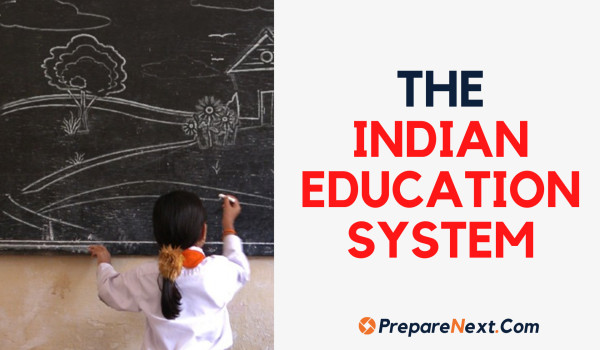The Indian education system

Gurukula system
Gurukula was a system of education in ancient times, in which students were taught at the homes of teachers. After becoming a student of the guru he would live at the guru's house and help him with all household chores. A student could stay as long as she wished or until the guru felt he had taught her everything he had to teach if he felt he had taught everything he had to teach. Learning in ancient India was closely connected to nature and skill set life, rather than confined to memorizing information.
Modern School System
It’s an undeniable fact that education in modern India is different from that of the Gurukula The curriculum is mostly taught in English or Hindi. Originally, the modern school system and English language were brought to India by Lord Thomas Babington Macaulay in the 1830s. At the time, the curriculum only included modern subjects. Philosophies and metaphysics were omitted. There was no connection with nature, and there was no close relationship between the teacher and the student.
Up until July 2020, the schooling system in India was based on the 10+2 system, which rewarded Secondary School Certificate (SSC) once completing class 10th and Higher Secondary Certificate (HSC) by completing class 12th.
According to the new National Education Policy, this system has been replaced by the 5+3+3+4 one. The stages are based on the phases of cognitive development a child naturally goes through.
There are four levels of compulsory education in India
1. the Foundation stage (ages 3-8),
2. the Preparatory stage (ages 8-11)
3. the Middle stage (ages 11-14)
4. Secondary stage (ages 14-18).
What is the new education policy in India?
A new National Education Policy (NEP) approved by the Union Cabinet in July 2020 will be implemented fully by 2040.NEP’s five major changes in school and higher education For the first time, formal schooling will cover young children aged three to five through the Right to Education Act (RTE) rather than six to fourteen years. Early childhood education is now included in the scope of formal education for the first time.
The NEP recommends students be taught in their mother tongues or regional languages until the fifth grade, to assist students in learning and grasping non-trivial concepts quickly. The Higher Education Commission of India (HECI) will regulate, accredit, and accredit the state and private higher education institutions as one body. By 2040, all colleges and universities will be multidisciplinary. This will provide students with the opportunity to combine subject areas based on their skill set and interest areas.
A Bachelor's degree will continue to be awarded after a minimum three-year program under the new policy, which allows colleges and universities in India to award certificates after one year of study in a field or a diploma after two years. In comparison with ancient gurukula, how does the modern Indian education system differ, here are some advantages and disadvantages of the new Indian education policy.
Advantages
In India, there are several advantages to the modern education system. The most notable are the benefits of science, technology, and innovation. These merits and more all contribute to making the modern education system more flexible, accessible, and convenient. This tech-based learning system also covers a wider range of subjects.
Ancient and medieval education are less accessible to people of all backgrounds, but the modern education system is more accessible to people of all ages.
Using technology, trainers and teachers can conduct virtual classes and seminars so students can complete their education without ever having to be in the same room as their instructors.
Modern schooling in India covers a vast area of subjects for students of all levels sp Students can choose from a wide array of fields and subjects to study.
Flexible and Convenient Many primary and secondary schools also now offer online and supplemental classes. This flexibility allows students to learn at their own pace.
Tech-Based Learning and School Administration
Disadvantages
Modern Indian education has some disadvantages as well, including not valuing the relationship between students and teachers as much as more traditional student-teacher relationships, putting too much emphasis on tests, and being overly reliant on technology.
The modern education system in India can sometimes be too technology-based.
Another disadvantage of the modern Indian education system is its fixation with tests and theoretical knowledge. Rather than learning how to apply theories and information to real-life situations, students tend to focus more on memorizing

Career Options in Digital Marketing
Digital marketing is one of the most popular career options in today's tech-savvy world. While browsing online, we are exposed to loads of content we consume in the forms of videos, gifs, memes, pictures, and more.

Career Options in Electrical Engineering
An electrical engineer designs, develops, tests, and supervises the manufacture of electrical equipment, such as electric motors, radar and navigation systems, communications systems, or power generation equipment. Automobile and aircraft electrical systems are also designed by electrical engineers.

Career Options in Rubber Technology

Career Opportunities in Mechatronics Engineering
Mechatronics specialists work at the intersection of mechanics, electronics, and computing to build simpler, smarter machines. In Simple Words, Mechatronics is the study of the interface between mechanical engineering and electronics.

Career Opportunities in Sculpture
A sculpture is a piece of art created from materials like terracotta, stone, clay, wood, metal, etc. that represents a person, thing, or idea. An artist who sculpts manmade or natural objects has expertise in transforming them into art pieces. Primitive art has evolved with new forms. Culture, folk arts, religion, and traditions are the inspirations for the sculpture.

Career Opportunities in Genetic Engineering
A genetic engineering technique involves the use of recombinant DNA to alter an organism's genetic makeup. A genetic engineer uses biotechnology to modify the genes of an organism.

Career Opportunities In Horticulture
In horticulture, plants are cultivated for their edible and medicinal qualities, as well as for ornamental purposes. In simple words, It is the practice or art of growing and cultivating plants and trees. what do horticulturists do? The term horticulturist refers to an agriculturist who cultivates flowers, fruits, nuts, vegetables, and herbs, as well as ornamental trees and lawns.

Career Opportunities in Graphic Designing
A graphic designer is an artist who designs artwork for print media and electronic media, such as books, television graphics, logos, and web design. To communicate ideas that inform and inspire consumers, they design visual concepts either by hand or using computer software. Designing advertisements, brochures, magazines, and corporate reports involves creating an overall layout and production design.

Career Opportunities in Gaming Industry
In the video game industry, there are a number of options for finding a career overseeing the development of concepts, and various gaming jobs might be perfect for anyone who enjoys gaming. As a competitive zone, video gaming requires professionals who can balance fun, creativity, and technology. However, what this industry needs most are passion and creativity.

Career Options In Nuclear Engineering
Nuclear engineering consists of the study of nuclear interactions and the transport of neutrons and gamma rays based on the principles of physics and mathematics. Nuclear engineering allows the study of nuclear reactions and the application of radiation.